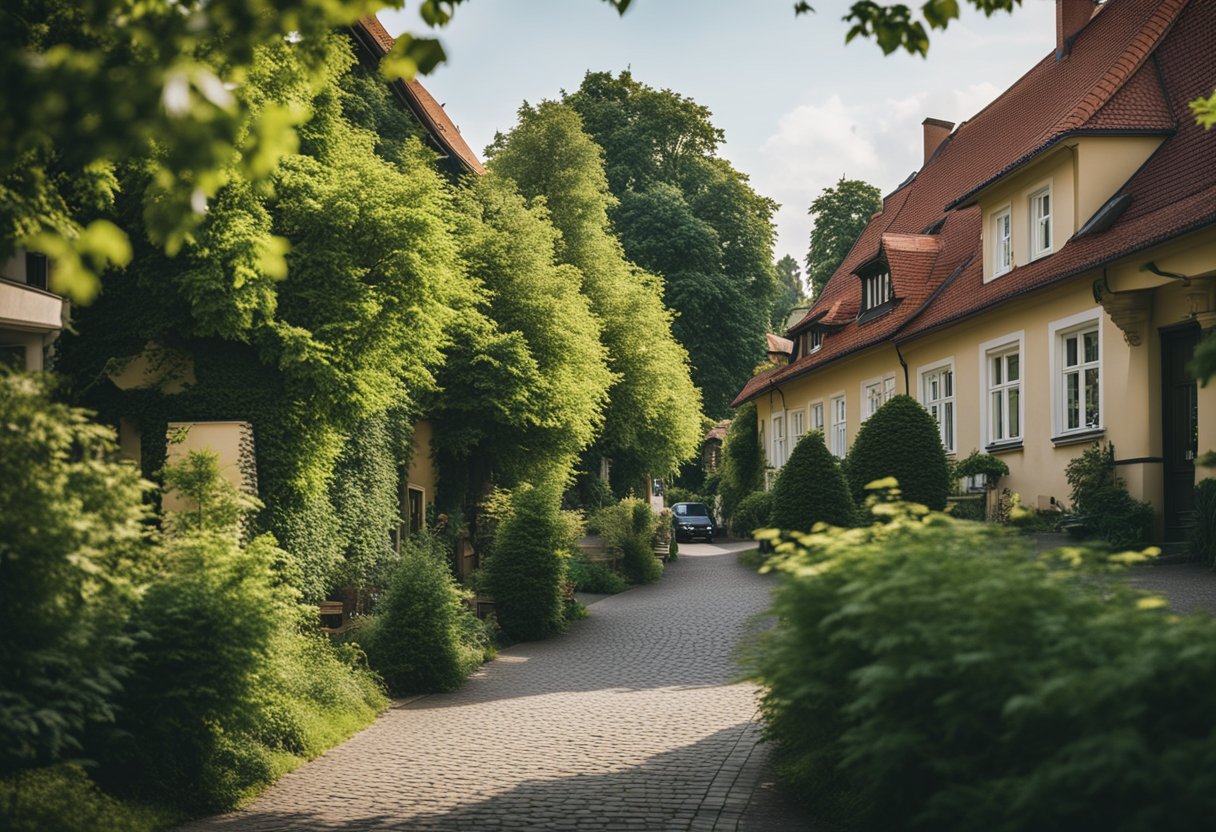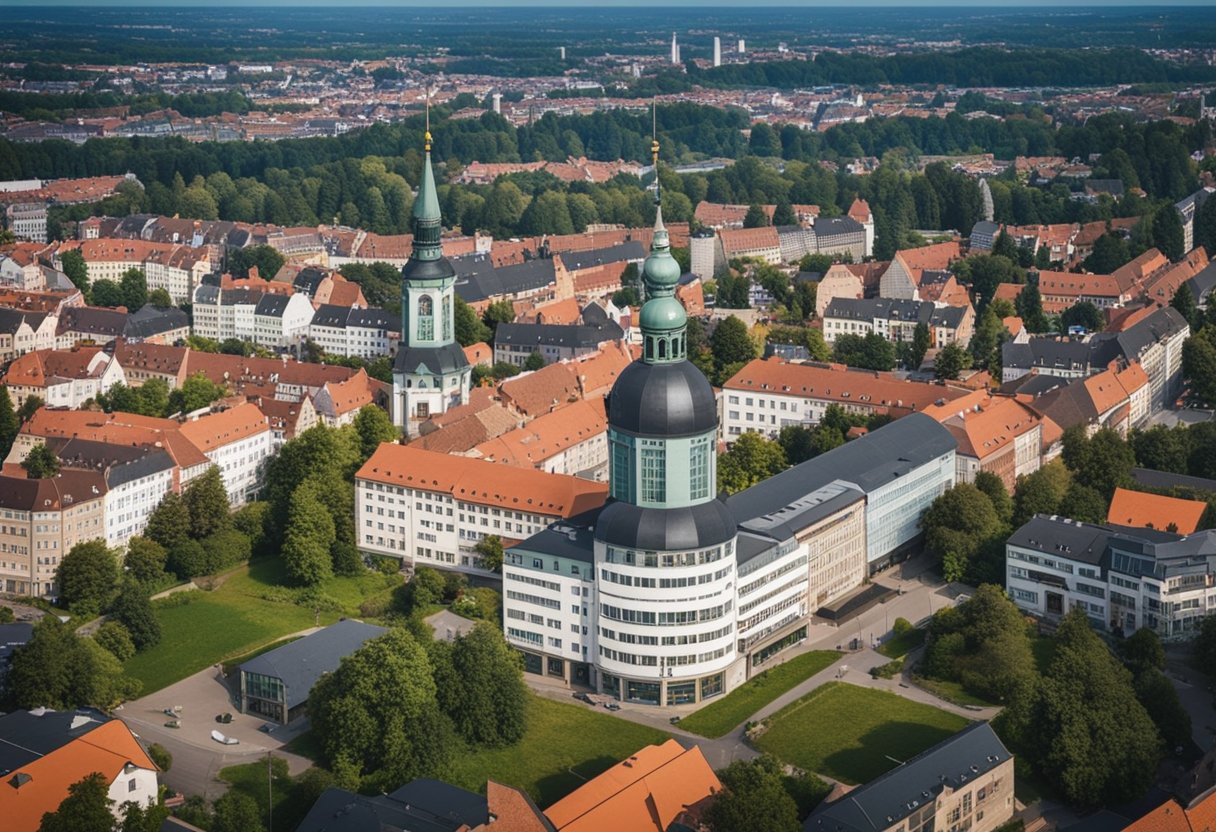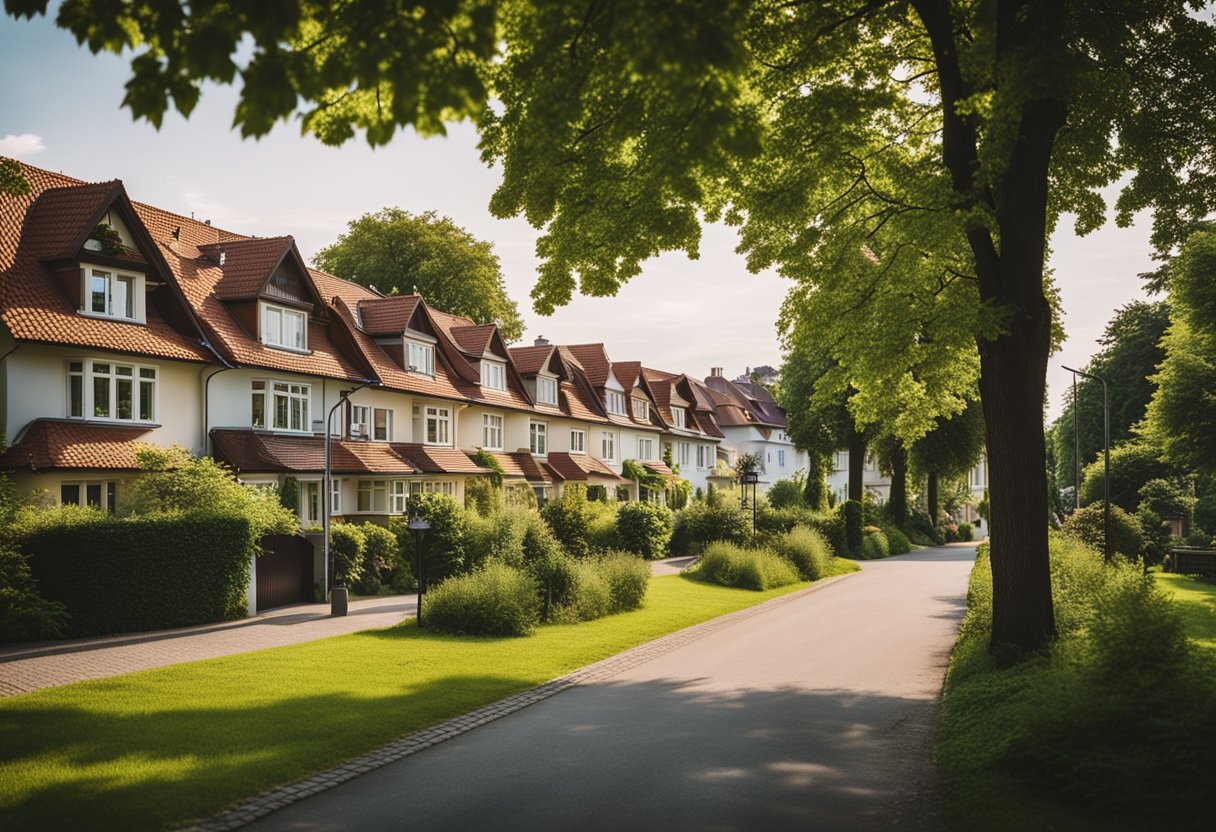Zehlendorf stands as a prestigious suburb in the southwest of Berlin, nestled within the borough of Steglitz-Zehlendorf.
This locality is not only renowned for its residential appeal but also for its prominent green spaces, encompassing forests and lakes that offer a peaceful escape from the city’s bustle.
With its unique blend of nature, academia, and culture, Zehlendorf in Berlin Germany holds diverse mosaic of neighborhoods.
The area boasts a significant history and contributes to Berlin’s academic and cultural scene, thanks in part to institutions like the Free University of Berlin located in the neighboring locality of Dahlem.
Zehlendorf, characterized by its well-preserved architecture and high quality of life, is also recognized for its specific postal code, making it an easily identifiable part of Berlin’s extensive postal system.
As a part of the Steglitz-Zehlendorf borough, which came into existence following Berlin’s 2001 administrative reform, Zehlendorf maintains a strong identity.
It serves as a testament to Berlin’s ability to integrate natural beauty, historical significance, and modern living within its vast urban landscape. This locality continues to be a sought-after area for residents who value tranquility without forfeiting the conveniences of city life.
Historical Overview-Zehlendorf in Berlin Germany
Zehlendorf boasts a rich tapestry of history that ranges from its early origins, through the distinct periods of 20th-century geopolitics, to the administrative changes of modern Berlin.
Origins of Zehlendorf
The locality of Zehlendorf, seated within the southwestern Berlin borough of Steglitz-Zehlendorf, can trace its lineage back to the medieval era.
It is first documented as Cedelendorp in 1242. Initially, Zehlendorf grew as a village on the Teltow plateau, reflecting the rustic charm typical of the Brandenburg region during the times of the Margraviate of Brandenburg and later Prussia.
Berlin’s 2001 Administrative Reform
The year 2001 marked a significant change for Zehlendorf when Berlin’s administrative reform integrated it into the newly established borough of Steglitz-Zehlendorf.
This reform abolished the former status of Zehlendorf as a separate borough, congregating it with other localities such as Wannsee and Dahlem to form a larger administrative entity that offers a blend of residential areas, education institutions, and green spaces.
Cold War Influence
During the Cold War, Zehlendorf stood on the frontline of global tension, bordered by the infamous Berlin Wall and experiencing the full spectrum of political divisions.
Its location in West Berlin made it not only a witness to the divisiveness of the era but also a point of scientific and cultural activity due to its proximity to institutions like the Free University of Berlin, situated in the neighboring suburb of Dahlem.
The Cold War-era shaped much of Zehlendorf’s modern identity and contributed significantly to its development during the 20th century.
Geography and Climate
Zehlendorf, a suburb of Berlin, Germany, is characterized by its varied topography, numerous water bodies, and a temperate climate that shapes the living environment.
Its geography integrates the Teltow plateau’s higher elevation with the presence of notable lakes and forested areas, which are significant for both the microclimate and the local ecosystem.
Topography and Elevation
Zehlendorf is situated on the Teltow plateau, which contributes to its elevated terrain compared to the central areas of Berlin. The elevation in Zehlendorf varies, with some areas slightly higher, offering a vantage point over the city.
Grunewald Forest, part of this region, is a large expanse of woodland that provides a natural elevation and a green retreat within the urban landscape.
Hydrography
The district’s hydrography is marked by several large water bodies. Schlachtensee and Krumme Lanke are two significant lakes that serve as recreational spots for both locals and visitors.
To the west, the expansive Wannsee offers a gateway to Potsdam with its connecting waterways. In addition, smaller lakes like Waldsee dot the landscape, contributing to Zehlendorf’s distinctive water-rich character within the urban environment.
Transport and Mobility
Zehlendorf, a locality in the borough of Steglitz-Zehlendorf in Berlin, is well-connected via various modes of transport, allowing residents and visitors to effortlessly navigate the area.
The locality benefits from a comprehensive public transit system and a network of major roads, ensuring efficient and accessible mobility options.
Public Transportation
Zehlendorf prides itself on its S-Bahn and U-Bahn services, which are pivotal to its public transportation network. The S-Bahn Station Mexikoplatz stands as a historical site, positioned beside the picturesque Teltowkanal, marking the significant role of the district in Berlin’s rail history.
Its S1 line connects Zehlendorf with central Berlin, facilitating convenient transit. Additionally, Onkel Toms Hütte, another S-Bahn station, further supports the suburb’s connectivity.
Beyond the S-Bahn, the U-Bahn provides additional layers of accessibility, though it is more concentrated around the city center.
- Key Stations:
- S-Bahn: Mexikoplatz, Onkel Toms Hütte
- S1 Line: Connecting Central Berlin to Zehlendorf
- Historical Considerations:
- Stammbahn: Zehlendorf was once served by this inaugural Prussian railway, enriching its historical significance.
Zehlendorf’s integration into the greater Berlin transport network was further reinforced with Berlin’s 2001 Administrative Reform, which optimized transportation routes across the boroughs, including Steglitz-Zehlendorf, facilitating better service coordination and urban connectivity.
Main Roads and Access
The transportation framework of Zehlendorf is complemented by Berlin’s major roads, which provide residents with direct routes to various destinations.
Berliner Straße is one such arterial road in the district, supporting both local and through traffic. This road continues to play a critical role in both the daily commute of the residents and the general transportation infrastructure of the district.
- Notable Roads:
- Berliner Straße: Major thoroughfare facilitating movement within and beyond the district.
Access to the city and regional destinations is well-supported through a network of roads intersecting with the Teltowkanal, underscoring the strategic location of Zehlendorf in relation to both land and waterway transport routes.
The canal itself has historical importance and remains a vital waterway for Berlin, contributing to the area’s multimodal transportation offerings.
Education and Science
Zehlendorf is known for its high academic standards and contributions to science, largely due to the presence of the prestigious Free University of Berlin and a multitude of research institutions.
Universities
The Free University of Berlin (Freie Universität Berlin), located in the Dahlem neighborhood of Zehlendorf, stands out for its exceptional research and education.
This university has gained a reputation for its dedication to the humanities and social sciences as well as natural and life sciences.
It also houses the iconic Philological Library, a masterpiece designed by the renowned architect Norman Foster.
Schools and Research Institutions
Zehlendorf is not only a hub for higher education but also accommodates a variety of schools and research institutions.
These facilities contribute significantly to the district’s scientific landscape, covering a spectrum of disciplines and fostering a culture of knowledge and innovation.
The area’s educational institutions are well-integrated with its research entities, providing numerous opportunities for academic growth and scientific discovery.
Culture and Lifestyle
Zehlendorf is a beacon of cultural richness and lifestyle diversity, with its array of museums, lush parks, and vibrant shopping and dining scene integrating influences from Italian to Japanese.
Museums and Historical Sites
Zehlendorf houses significant historical and cultural sites. The Allied Museum documents the political history and military commitments of the Western Allies in Berlin.
Another gem is the Museum Village Düppel, which showcases medieval life, while the House of the Wannsee Conference stands as a poignant memorial and educational site.
Art lovers can visit the Brücke-Museum to admire expressionist works, or the Museum of Asian Art for a taste of Eastern culture.
Parks and Recreation
Numerous parks in Zehlendorf offer recreational spaces, with the Botanical Garden being one of the most distinguished, featuring a vast collection of flora.
The Grunewald Forest, adjacent to Zehlendorf, provides a natural escape with its expansive woodlands. Historical estates like Jagdschloss Grunewald and the beautiful Glienicke Palace are nestled in these green spaces, enriching the outdoor experience with a touch of history.
Shopping and Dining
The vibrant shopping scene in Zehlendorf is anchored by the Schloßstraße, a shopping street filled with a variety of stores. For a more centralized shopping experience, visitors can explore the local shopping centres.
Culinary diversity blooms here as well, from traditional German to international cuisine. Restaurants offering Italian, Polish, Russian, Japanese, and Spanish dishes reflect Zehlendorf’s multicultural essence.
Real Estate and Living
Zehlendorf is a locality in the Steglitz-Zehlendorf borough of Berlin, known for its blend of affluence and natural beauty. This area offers a variety of real estate options from single-family homes to expansive villas.
Housing Market
The housing market in Zehlendorf is characterized by a selection of high-quality real estate. Prospective buyers and tenants can expect to encounter high rents and property prices that reflect the area’s desirability.
For instance, details from Guthmann Estate indicate that Zehlendorf maintains its reputation as one of Berlin’s upscale addresses, offering a quality lifestyle for its residents.
Engel & Völkers lists properties such as a single-family house priced at €1,200,000 featuring seven rooms and a generous living space of 175 m². Larger, more opulent properties such as the Breuhaus Villas are marked at higher price points, like a notable villa in Dahlem priced at €6,900,000 offering six rooms and a living area of 340 m².
Residential Areas
The residential areas of Zehlendorf are diverse, ranging from quiet housing estates to luxurious villas. Single-family homes are a common sight, providing a peaceful living environment amidst the area’s cultural and natural settings. Engel & Völkers showcases a variety of homes in this category, reflecting Zehlendorf’s high standard of living.
Realty-Germany amplifies this by presenting a range of properties for sale in the area, including offers such as a buy-to-let apartment at 78 m² for €339,000.
The residential mix demonstrates that while Zehlendorf is home to predominantly affluent properties, there are opportunities for investment at various levels, reflecting the locality’s comprehensive real estate market.
Natural Attractions
Zehlendorf, a locality in the borough of Steglitz-Zehlendorf in Berlin, Germany, boasts an abundance of natural attractions, including pristine lakes, expansive forests, and well-tended gardens. These green spaces provide both serene retreats and exciting outdoor activities for locals and visitors alike.
Lakes and Forests
- Schlachtensee: Nestled in the Steglitz-Zehlendorf borough, Schlachtensee is a popular destination for swimming and boating. This lake is encircled by walking trails that offer peaceful escapes into nature.
- Krumme Lanke: Another lake, Krumme Lanke, invites visitors to enjoy water-based activities and is surrounded by tranquil paths perfect for jogging or leisurely strolls.
- Grunewald Forest: The sprawling Grunewald Forest is a natural treasure that provides miles of hiking and biking trails. This forest is home to diverse wildlife and offers a variety of recreational opportunities.
- Wannsee: The Wannsee is celebrated for its beach, the largest inland beach in Europe, and is a popular spot in Zehlendorf for sunbathing and water sports.
Gardens and Green Spaces
- Botanical Garden: Boasting an impressive collection of flora from around the world, the Botanical Garden in Zehlendorf is a lush sanctuary for plant lovers and those seeking knowledge.
- Pfaueninsel: Translated as Peacock Island, this nature reserve features a historical park populated with free-roaming peacocks, adding a magical touch to the scenic landscape.
- Green Spaces: Green spaces are abundant in Zehlendorf, offering locals and visitors a breath of fresh air and areas for relaxation. Public parks and gardens are meticulously maintained and provide a habitat for various plant and animal species.
- Steinstücken: As a unique feature of Zehlendorf, Steinstücken is known for its historical significance and the green spaces that contribute to the district’s natural charm.
Local Governance
Zehlendorf’s governance is markedly local in its structure and political operations. This section explores the details of the local administrative arrangements and the political climate within which they function.
Administrative Structure
Steglitz-Zehlendorf, a borough comprised of several localities including Zehlendorf, operates under Berlin’s two-tier local government system.
This Bezirk serves as the primary administrative unit for Zehlendorf, managing its local affairs including urban planning, schools, and social services. The postal codes for Zehlendorf range within the 141xx block, identifying it geographically within the city’s addressing system.
Political Landscape
The political landscape of Steglitz-Zehlendorf is typically reflective of Berlin’s broader political spectrum. Parties such as The Left (Die Linke) have a presence here, competing in local Bezirksverordnetenversammlung (District Assembly) elections.
These assemblies are tasked with important local decisions, including budgetary allocations and development projects. The population of the borough, in excess of 200,000, as per the contexts found in relevant search results, drives diverse political views and priorities.
Frequently Asked Questions
This section addresses common inquiries regarding Zehlendorf, providing details on attractions, history, accommodation, shopping, and natural landmarks within this distinguished district of Berlin.
What are the top attractions to visit in Zehlendorf?
Visitors in Zehlendorf should not miss experiencing the Free University of Berlin, a hub of science and culture situated in the Dahlem neighborhood, and the meticulously planned Garden City on Berlepschstraße, a notable example of early 20th-century urban planning.
Can you provide a brief history of Zehlendorf in Berlin?
Zehlendorf has a rich history, with its subdivisions like Düppel dating back to village settlements. It has developed into a distinguished residential area, also remembered for Dahlem Church and significant figures like Pastor Martin Niemöller.
Where can visitors find accommodation in Zehlendorf?
There is a variety of accommodation options in Zehlendorf, from quaint bed and breakfasts to more luxurious hotels, ensuring visitors can find a comfortable place to stay that suits their preferences and budget.
What shopping options are available in the Steglitz-Zehlendorf borough?
The Steglitz-Zehlendorf borough provides a multitude of shopping opportunities, from traditional boutiques and specialty shops to modern malls, catering to both locals and tourists alike.
Are there any lakes or natural landmarks to visit in or near Zehlendorf?
Zehlendorf is renowned for its lakes and natural landmarks, including Schlachtensee and Krumme Lanke, which are perfect for leisurely walks, picnics, or a refreshing swim during the summer months.
What is special about the district of Zehlendorf in the context of Berlin’s overall character?
Zehlendorf stands out in Berlin for its serene ambiance, high quality of life, and the blend of culture, education, and nature. Nearly half its area comprises forest and water areas, giving it a unique edge over the typically bustling urban districts of Berlin.




